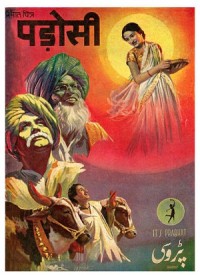| Padosi | |
|---|---|
 | |
| Directed by | V. Shantaram |
| Written by | Vishram Bedekar |
| Produced by | Prabhat Film Company |
| Starring | Gajanan Jagirdar Mazhar Khan Radhakrishan Anees Khatoon |
| Cinematography | V. Avdhoot |
| Music by | Master Krishnarao |
Production company | Prabhat Film Company |
Release date |
|
Running time | 135 minutes |
| Country | India |
| Languages | Marathi Hindi |
Shejari (Marathi: शेजारी)[1] is also known as Padosi in Hindi version as (पड़ोसी, پڑوسی Neighbour). Padosi is a 1941 Indian social drama film directed by V. Shantaram.[2] It was produced by Prabhat Film Company and the bilingual film in Marathi and Hindi was the last film Shantaram made for Prabhat before venturing to form his Rajkamal Kalamandir.[3] The film is cited as one of the three social classics Shantaram made at Prabhat. The other two were Duniya Na Mane (1937) and Aadmi (1939).[4] The story and dialogue were by Vishram Bedekar in the Marathi version, while the dialogues in the Hindi version were by Pandit Sudarshan, who also wrote the lyrics. The music director was Master Krishnarao. The famous character artist Radhakrishan made his acting debut in the film as a villain.[5] The film starred Mazhar Khan, Gajanan Jagirdar, Anees Khatoon, Radha Kishan, Lajwanti, Sumitra, Gopal and Balak Ram.[6]
The story concentrated on the topical issue of Hindu-Muslim unity, making a "strong plea" for it.[7][8] The film was made against the backdrop of communal tension at the formation of the Muslim League. Shantaram attempted a theme showing amicable relations between the Hindus and the Muslims. To achieve a better geniality, he had Mazhar Khan, a Muslim playing a Hindu and Gajanan Jagirdar, a Hindu play the Muslim character.[4]
With his trio of social films and especially Padosi, Shantaram has been cited by author Bajaj as the third best pre-1960 director in the top ten rating, following P. C. Barua for Devdas (1935) and Homi Wadia for Miss Frontier Mail (1936), followed by Mehboob Khan for Mother India (1957).[9]
- ^ "SHEJARI (1941)". BFI. Archived from the original on 7 January 2019. Retrieved 31 March 2023.
- ^ "Padosi (1941)". Gomolo. Retrieved 10 February 2015.
- ^ K. Moti Gokulsing; Wimal Dissanayake (17 April 2013). Routledge Handbook of Indian Cinemas. Routledge. pp. 78–. ISBN 978-1-136-77284-9. Retrieved 9 February 2015.
- ^ a b S. Lal (1 January 2008). 50 Magnificent Indians Of The 20Th Century. Jaico Publishing House. pp. 275–. ISBN 978-81-7992-698-7. Retrieved 9 February 2015.
- ^ Sanjit Narwekar (12 December 2012). Eena Meena Deeka: The Story of Hindi Film Comedy. Rupa Publications. pp. 115–. ISBN 978-81-291-2625-2. Retrieved 9 February 2015.
- ^ "Padosi 1941". Alan Goble. Retrieved 10 February 2015.
- ^ Ashok Raj (1 November 2009). Hero Vol.1. Hay House, Inc. pp. 33–. ISBN 978-93-81398-02-9. Retrieved 9 February 2015.
- ^ Tilak Rishi (2012). Bless You Bollywood!: A Tribute to Hindi Cinema on Completing 100 Years. Trafford Publishing. pp. 11–. ISBN 978-1-4669-3963-9. Retrieved 9 February 2015.
- ^ J.K. Bajaj (26 March 2014). On & Behind the Indian Cinema. Diamond Pocket Books Pvt Ltd. pp. 2008–. ISBN 978-93-5083-621-7. Retrieved 9 February 2015.